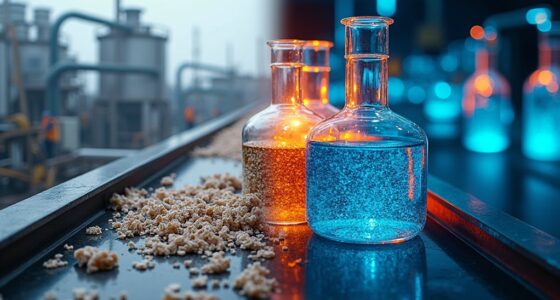Microbial mining uses bacteria to extract metals from ore, offering a greener alternative to traditional cyanide methods. Instead of chemicals, specific bacteria like *Acidithiobacillus ferrooxidans* oxidize sulfide minerals, releasing metals into solution. This process is environmentally friendly, cost-effective, and helps recover metals from low-grade deposits. It’s a sustainable way to enhance metal recovery while reducing hazards. If you’re curious to learn more about how bacteria revolutionize mining, keep exploring this innovative approach.
Key Takeaways
- Microbial mining uses bacteria like *Acidithiobacillus ferrooxidans* to dissolve metals from ores, replacing toxic chemicals like cyanide.
- Bacteria oxidize sulfide minerals, making metals soluble and easier to extract through bioleaching and biooxidation processes.
- This method is environmentally friendly, reducing reliance on harmful chemicals and minimizing ecological hazards.
- Microbial mining is cost-effective, especially for low-grade ores, enhancing metal recovery efficiency.
- It supports sustainable and energy-efficient metal extraction, aligning with eco-conscious mining practices.

Have you ever wondered how microbes can help extract valuable minerals from the Earth? It might sound surprising, but bacteria are becoming key players in modern mining through a process called microbial or biological mining. Instead of relying solely on traditional methods like blasting and chemical extraction, scientists are harnessing bacteria’s natural abilities to recover metals efficiently and more sustainably.
One of the most prominent techniques involves bacterial leaching, where specific bacteria are used to dissolve metals from ore. These microorganisms interact with mineral deposits, breaking down the ore and releasing metals into solution, which can then be collected and processed further.
Bacterial leaching is a cornerstone of biooxidation processes, which notably reduce the need for harsh chemicals in metal extraction. During biooxidation, bacteria such as Acidithiobacillus ferrooxidans or Leptospirillum are introduced to the ore. These bacteria thrive in acidic environments and have the remarkable ability to oxidize sulfide minerals, transforming them into soluble forms. Microbial activity also influences the efficiency of biooxidation, making it a critical factor in optimizing extraction processes.
This biological oxidation simplifies the extraction process, making it more environmentally friendly and cost-effective compared to traditional methods. For instance, in copper mining, biooxidation helps break down complex sulfide ores, freeing the metal so it can be extracted more easily. This process minimizes the use of toxic chemicals like cyanide or mercury, reducing environmental hazards and health risks for workers.
You might also find it fascinating that bacterial leaching and biooxidation processes can recover metals from low-grade ores that would otherwise be uneconomical to process. Instead of discarding these low-value deposits, mining companies can use bacteria to extract metals efficiently, making the entire operation more sustainable.
Additionally, these microbial methods are often faster than traditional extraction techniques, especially in challenging environmental conditions. As bacteria naturally thrive and perform their functions in acidic, mineral-rich environments, they enable continuous and energy-efficient processing. This innovative approach aligns with the growing demand for sustainable mining practices worldwide.
Frequently Asked Questions
What Are the Environmental Impacts of Microbial Mining?
You might wonder about microbial mining’s environmental impacts. It can reduce environmental pollution compared to traditional methods, but it still poses risks like affecting biodiversity.
Bacteria used in extraction may introduce pollutants or disrupt local ecosystems if not carefully managed. While it’s a greener alternative, you should consider potential biodiversity impacts and environmental pollution that could result from improper handling or containment issues during the mining process.
How Cost-Effective Is Bacterial Metal Extraction Compared to Traditional Methods?
When comparing bacterial metal extraction to traditional methods, you’ll find it’s often more cost-effective, especially for low-grade ores.
The economic feasibility improves because bacteria require less energy and fewer chemicals, reducing operational costs.
In the cost comparison, microbial mining minimizes environmental cleanup expenses and uses simpler infrastructure.
Are There Specific Bacteria Used for Different Metals?
Imagine a vibrant garden where each plant targets a specific nutrient; bacteria work similarly with bacterial specificity. For metal targeting, you’ll find different bacteria tailored to extract particular metals—Acidithiobacillus for copper, Leptospirillum for iron, and others for gold or uranium.
This bacterial specificity allows precise, eco-friendly extraction, making it essential to select the right bacteria for each metal, ensuring efficient and sustainable microbial mining processes.
What Are the Challenges in Scaling Microbial Mining Processes?
You might wonder about the challenges in scaling microbial mining processes. Process scalability can be tricky because maintaining consistent bacterial cultivation at larger volumes is complex.
Factors like nutrient delivery, oxygen supply, and controlling environmental conditions become more difficult as you expand. Additionally, ensuring efficiency and cost-effectiveness while preventing contamination are key hurdles.
Overcoming these issues requires careful planning and advanced bioreactor designs to make microbial mining viable on a larger industrial scale.
How Long Does the Microbial Extraction Process Typically Take?
You might think microbial extraction is quick, but the timing variability can turn it into a frustratingly slow dance. The process duration varies widely depending on environmental conditions and ore types.
While some methods take weeks, others stretch into months. So, don’t expect a rapid turnaround—this eco-friendly approach demands patience, making it feel more like watching paint dry than a swift metal harvest.
Conclusion
Imagine a future where bacteria become your best allies in mining, turning toxic methods into eco-friendly solutions. Microbial mining isn’t just a trend; it’s a revolution that transforms pollution into progress. By harnessing nature’s tiny workers, you can help protect the planet while still extracting the metals we need. Isn’t it time to let bacteria lead the way, showing that even the smallest creatures can make the biggest difference? The future’s microbial handshake awaits.









